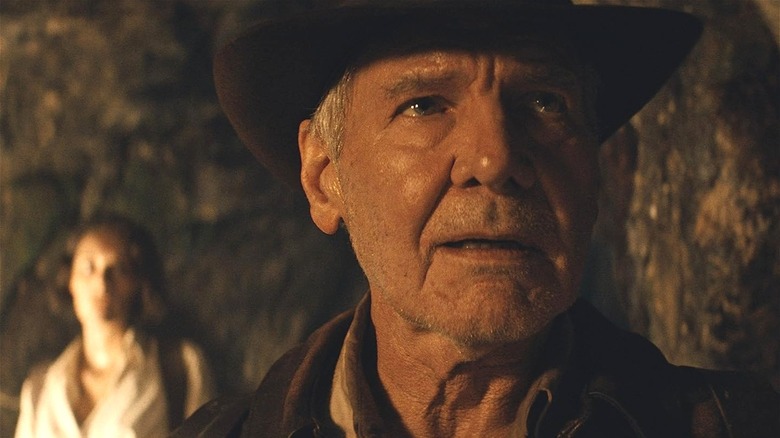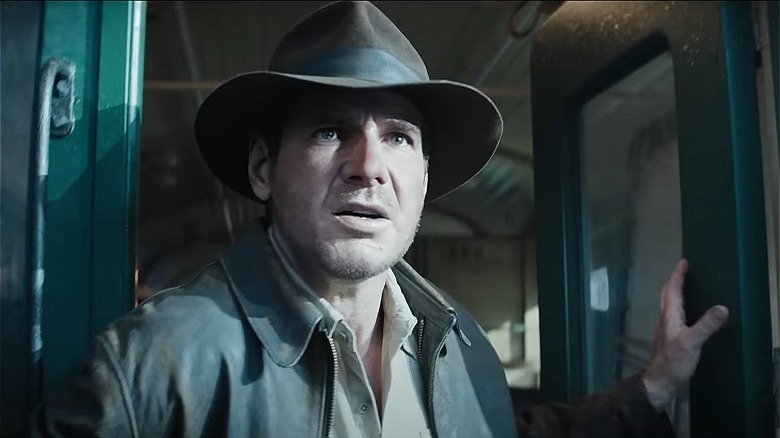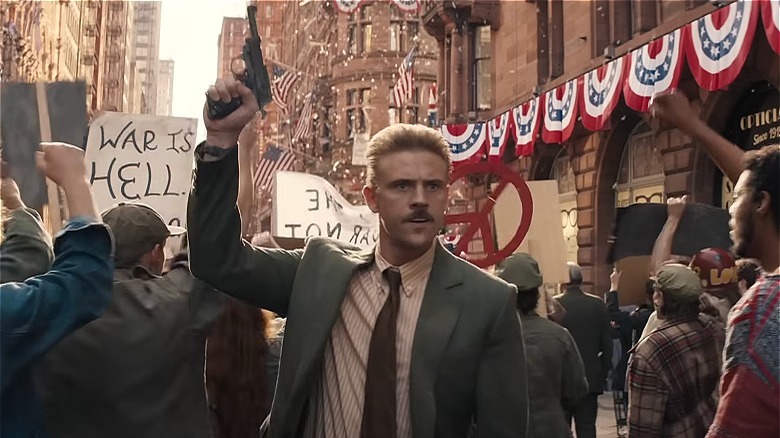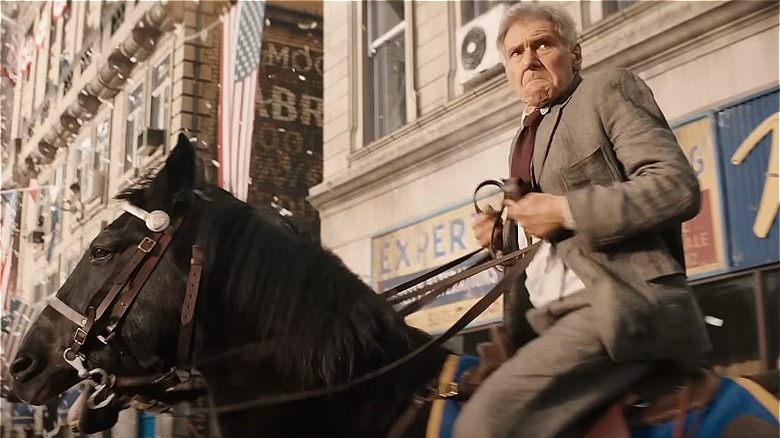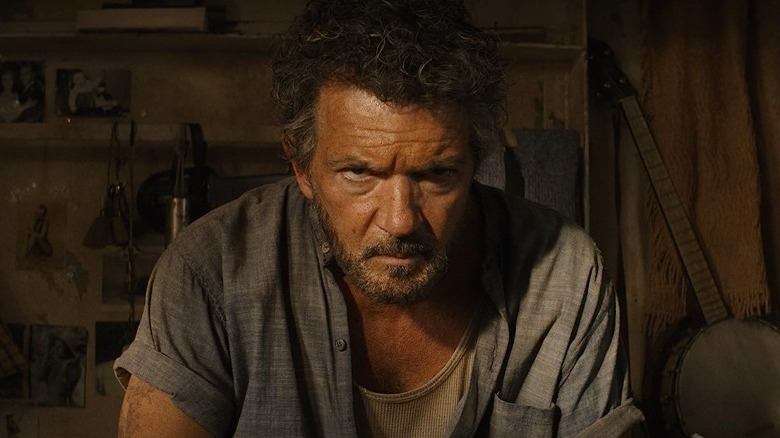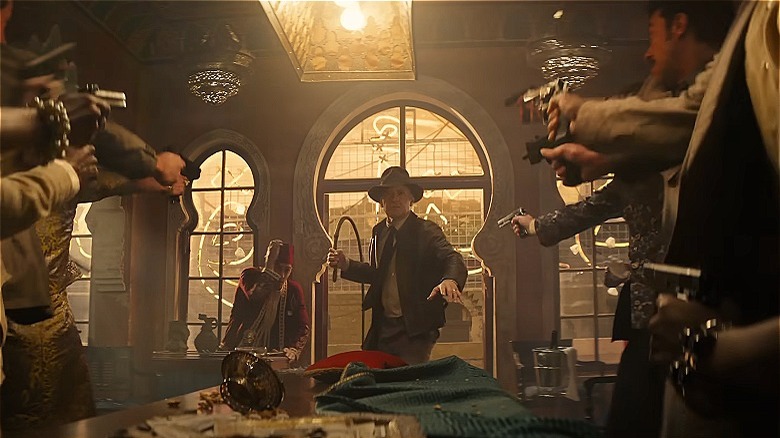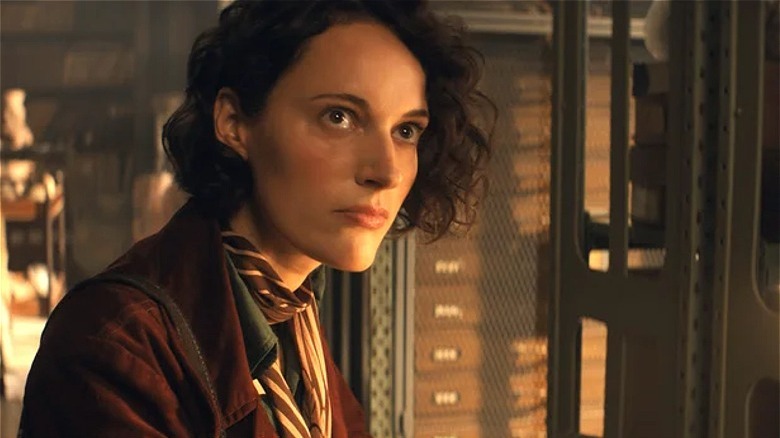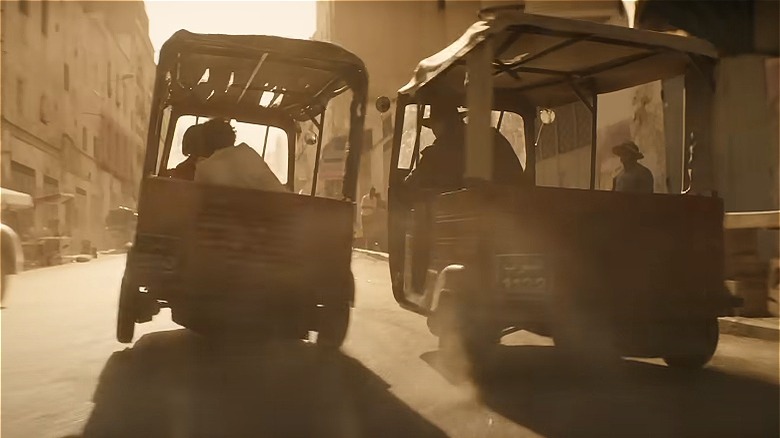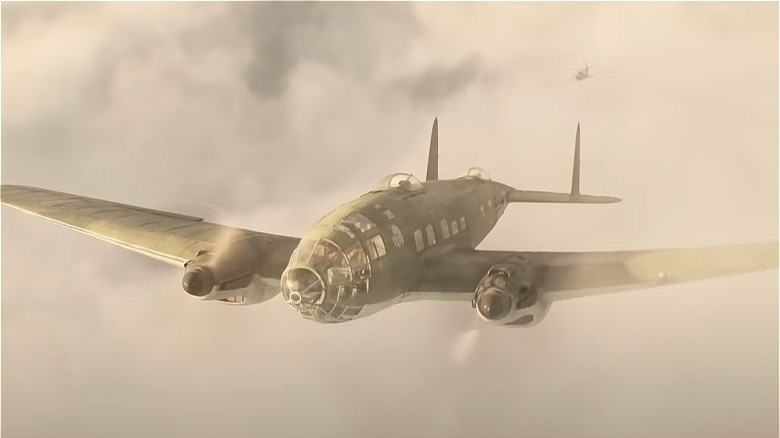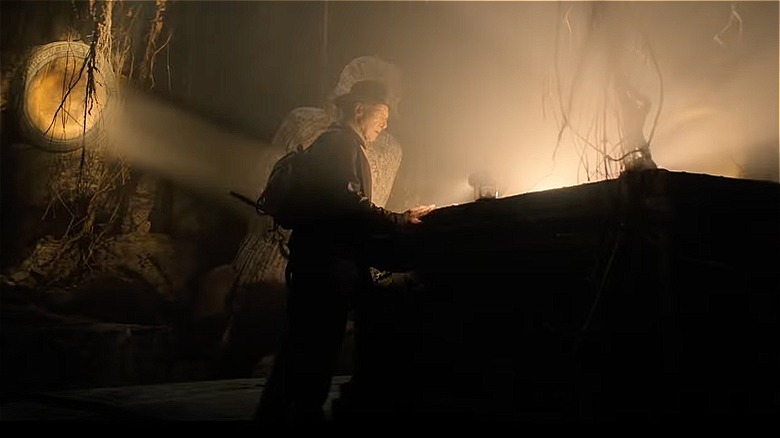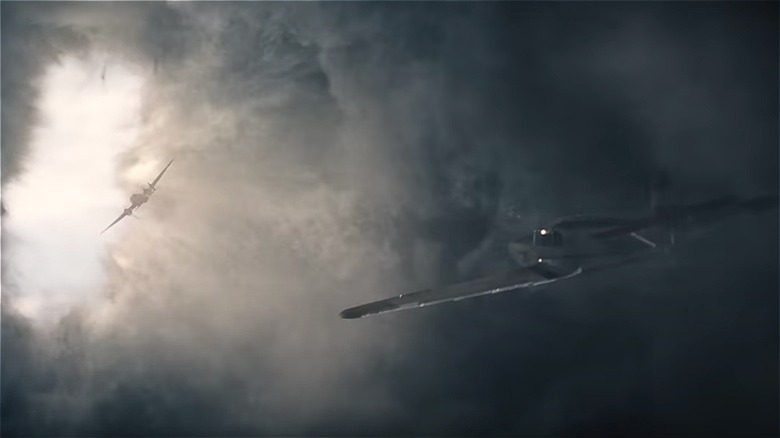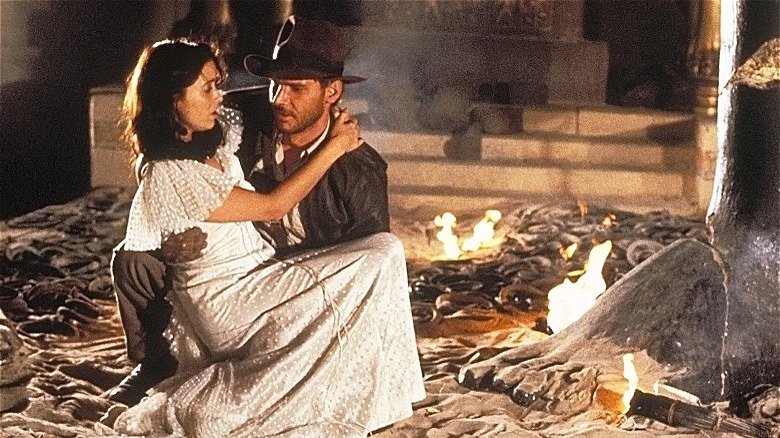The 6 Best And 4 Worst Moments In Indiana Jones And The Dial Of Destiny
The following post contains spoilers for "Indiana Jones and the Dial of Destiny."
Few characters are more instantly recognizable than the whip-cracking, treasure-hunting, Nazi-punching professor of archeology known as Indiana Jones, played to perfection by Harrison Ford. While the franchise has had ups and downs over its 42-year history, "Raiders of the Lost Ark" still ranks number 10 on AFI's list of the "100 Most Thrilling American Films" and is considered one of the best adventure films ever made. Its sequel, "Temple of Doom," was deemed a bit too dark upon release, but it has gained a broader appreciation in the decades since. "The Last Crusade" remains a rip-roaring crowd-pleaser thanks to Sean Connery and Ford's brilliant father-son chemistry. Given that "Kingdom of Crystal Skull" was not a fan favorite, everyone hoped that the fifth and (supposedly) final entry in the series would give Indiana a proper send-off.
While "Dial of Destiny" may not reach the cinematic heights of the original trilogy, it's leagues better than "Crystal Skull." It takes big swings in the final act, making it a bigger and wilder adventure than anything Dr. Jones has previously experienced. Setting the film in the aftermath of the Apollo 11 Moon landing creates the perfect environment for Indy to reflect on a changing world, and to question whether or not it still has a place for aging adventurers like himself. While several jokes target Indy's age, the script also includes poignant moments during which our hero reflects on his big regrets and losses, and we never doubt that Harrison Ford has still got it. Even after all these years away, the character still fits as well as Indy's trusty fedora.
Best: Young Indiana vs a train full of Nazis
"Dial of Destiny" opens with a classic pulpy adventure sequence, dropping the audience straight into the Allies' liberation of Europe. Indy escapes a hanging and an Allied bomb, then hijacks multiple Nazi vehicles "Grand Theft Auto"-style until he hops aboard a train filled with stolen artifacts — and Nazis. Once there, Indy uses his wits and fists to fight through each car. Indy trades blows with antagonist Jürgen Voller (Mads Mikkelsen) until he and fellow archeologist Basil Shaw (Tobey Jones) cannonball into the river below as the train derails in a fiery heap.
This entire sequence plays out like the finale of a classic Indiana Jones adventure. It's jam-packed with action and Nazi-punching goodness. While a few moments stretch the audience's suspension of disbelief, we never reach full "nuke the fridge" territory. Harrison Ford's digital de-aging is uncannily real at times and just uncanny valley at others; nevertheless, it's still the best use of this technology we've seen on either the big or small screen. Even with the CGI, it's a joy to see Indiana Jones back in his prime, and it creates a perfect contrast with the main story, in which Indiana is an aging hero embarking on one last quest.
Worst: Unmotivated goons
Mads Mikkelsen's Voller has an intriguing reason to want this film's MacGuffin, Archimedes' dial: He intends to use the dial's time travel capabilities not to help Hitler, but to kill Hitler and replace him as leader of the Nazi party. It's a sneaky subversion of an age-old trope. Sadly, his henchmen seem to be along for the ride for ... reasons? Boyd Holbrook plays Klaber, Voller's right-hand goon who's quick to do his boss' bidding and kill any random civilian who gets in the way. Klaber participates in a thrilling chase through an Apollo 11 parade, but aside from a propensity for solid action beats and general bad-guy vibes, we don't learn anything else about him.
Klaber is cold and ruthless, and his propensity for casual violence is shocking, especially when he brutally guns down two of Indy's co-workers, framing Indy for their murders (a superfluous subplot that receives zero resolution). We get vague hints that Klaber is a racist and a misogynist in the way he talks to Mason (Shaunette Renée Wilson). But why is Klaber helping Voller? What is his stake in this potentially world-altering plot? We don't know because the script never bothers to tell us. Holbrook plays Klaber with an appropriate amount of menace. We just wish his character wasn't paper-thin.
Best: The parade chase
Shortly after reuniting with her godfather, Helena (Phoebe Waller-Bridge) steals Indiana's half of the dial, then leaves him in the lurch to deal with Voller and his cronies. Indy escapes into a bustling parade that's celebrating the triumphant return of the Apollo 11 crew and America's victory in the Space Race. He hops on a horse while Klader steals a motorcycle, nodding to the film's thematic battle between the old and the new. Then, they race through marching bands and around classic cars as confetti laces the sky, eventually heading into a busy subway station. Indy escapes Klaber's clutches by racing off into the tunnels, dodging one subway car and outrunning another.
This entire chase contains all the wacky fun we've come to expect from the franchise. Sure, there are moments when it's clearly shot against a green screen, or when the face-matching on the stunt performers is a little wonky, but the sequence works. It captures the nationwide excitement over the Moon landing while simultaneously exploring the event's grimy underside. Ex-Nazi scientists like Voller helped NASA build the rockets that took American astronauts to the Moon; now, the protection Voller receives from the U.S. government gives him the freedom he needs to carry out his world-altering plan.
Worst: Antonio Banderas' cameo
Indy and Helena's escapades take them to the Aegean Sea, where they need to explore a shipwreck in order to find an ancient tablet with instructions on how to use the dial. Diving isn't a skill listed on Indy's resume; luckily, his old friend Renaldo (Antonio Banderas) is just the man for the job. Indiana and Renaldo enjoy a brief mini-reunion before they immediately hop on the latter's boat. During the dive, there's a fun callback to Indy's fear of snakes when dozens of eels pop out of the shipwreck and surround him. It's only a moment of peril, though, since he's swiftly brought back aboard the ship, where he finds Voller surrounded by Renaldo's dead shipmates. Sadly, Renaldo joins them in the afterlife minutes later.
As Banderas told Collider, while his appearance is "almost a cameo," he was "very happy to be part of a saga that is of the history of motion pictures, obviously." That said, when you cast an actor like Antonio Banderas, you create certain expectations. We're not asking for an entire flashback featuring Renaldo and Indy. A brief dialogue scene in which the two reminisce about their old adventures would have sufficed — any glimpse into their friendship, really, to make us care when Voller unceremoniously kills Renaldo. As it is, however, there's no emotional payoff, even though we assume there's supposed to be. Renaldo's non-existent backstory and quick demise make this diving side quest feel half-baked.
Best: The reverse Raiders of the Lost Ark bit
Indy pursues Helena to Tangier, where he finds her auctioning off Arhimedes' dial to a room full of ne'er-do-wells. Voller shows up and claims to be the rightful owner of the dial. Indy says that Voller stole it. Voller counters that Indy stole it too; Helena stops their pissing match with the quippy line, "And then I stole it. It's called 'capitalism.'" So, Indy grabs the dial and swings his whip around the room. He pauses, believing he's put everyone in their places, only for the criminals to draw dozens of guns. Indy dodges, bullets fly, and a full-on brawl follows.
Done right, fan service can hit like a warm hug. Done wrong, and it feels like a pandering cash grab. This specific moment in "Dial of Destiny" is an example of the former, exhibiting how nostalgic nods work best when they're motivated by the character and the story. It's a fun reversal of the famously brief "Raiders of the Lost Ark" sword fight, with Indy showing off his whip skills to a room full of unimpressed bad guys with firearms. It also plays up the idea that Indy's older and out of touch with the modern-day underworld, but it doesn't make him a cartoon character. Even at his age, Indy packs quite a punch and survives several daring escapes; still, as this scene reminds us (and him), he's only human.
Worst: Helena, the impossible stowaway
Helena, played with snarky delight by Phoebe Waller-Bridge, proves more than capable of taking care of herself throughout "Dial of Destiny." However, one of her daring feats comes across as a little silly. Voller, his crew, and a wounded Indy barrel down the runway in a WWII aircraft while Helena races alongside in the rain on a stolen motorcycle. She manages to get close enough to the plane's landing gear to leap onto it, and somehow holds on to the rain-soaked bearings as the plane takes off into the sky.
While some corners of the internet disliked Helena even before the film's release, we agree with /Film's Lex Briscuso, who calls Waller-Bridge a "worthy companion with grit, brawn, and brains." Helena goes toe-to-toe with Indy repeatedly, and they have a fun antagonistic chemistry that leads to an emotionally satisfying understanding and mutual respect. This scene, however, is not Helena's finest, mainly because the effects are murky. It's not a terribly original stowaway plan, either. We hesitate to say that it's far-fetched given that the Indiana Jones franchise is loaded with similarly unbelievable moments. It's just that the sheer impossibility of the stunt, the lackluster CGI, and the been-there-done-that vibes make the end result feel more shrug-worthy than anything else.
Best: Tuk-tuk chase
It wouldn't be an Indiana Jones movie without a thrilling chase sequence. Thankfully, "Dial of Destiny" treats us to several, although the tuk-tuk chase through Tangier takes the proverbial cake. Following Helena's botched auction, Voller takes off with the dial, forcing Indy, Helena, and this movie's Short Round 2.0, Teddy (Ethann Isidore), to pursue via tuk-tuks. Making matters even more chaotic, Helena's ex-fiance, the local gangster Rahim (Alaa Safi), joins the pursuit in hopes of winning her back. Rahim's lovesick calls to Helena as bullets fly by are funny, while the impressive stunt work on display as the tuk-tuks zigzag through crowded marketplaces, narrow alleyways, and down hundreds of stairs is a sight to behold.
This chase gives each hero a turn at the wheel, changing the dynamics and adding exciting new elements to the action choreography at every turn. At the beginning, Helena and Indy race in separate vehicles until an oncoming car forces Indy to jump onto the back of Helena's rickshaw. Indy eventually takes charge, and there's a fun bit of bickering as Helena and Teddy serve as backseat drivers. How can someone not love a set piece filled with fantastic practical effects (and some not-so-great green screen), quips, and car crashes? It's classic Indiana Jones, bringing humor and thrills in equal measure.
Worst: Teddy learns to fly
If you thought Helena's stowaway bit was silly, get ready for Teddy's first flight. As far as we can tell, Teddy has never flown a plane before; we doubt he's even been in a cockpit. That doesn't stop him from hopping into the nearest propeller plane and flying after Indy and Helena into a fissure in time that transports them all back to 214 B.C. That's already a little too convenient, and that's before we account for the pilot of Teddy's stolen plane sleeping through the extremely rocky take-off, only waking up once they've time-traveled.
Yes, this franchise is known for outlandish escapes, but something about Teddy's is simply too much. One line about his dreams of becoming a pilot, or a reference to a stolen plane or two during his previous adventures with Helena, or any small detail like that, is really all we need. But Teddy ends up in the past and dodges ancient projectiles with little help from the narcoleptic pilot and no explanation from the film. The contrived plot beat almost feels like a placeholder until the writers could figure out a better way to get Indy and Helena back through the fissure. Unfortunately, it made the final cut. It's not the worst thing to ever happen to the Indiana Jones series, but it'll elicit a few eye rolls.
Best: Old-school treasure hunting
"Raiders of the Lost Ark" established that every Indy outing needs a solid treasure-hunting sequence, and "Dial of Destiny" delivers just that. Indiana and Helena navigate treacherous cliffs, creaky bridges, and narrow corridors filled with creepy crawlies as the Nazis nip at their heels. Eventually, they decode Shaw's journals and use water to uncover Archimedes' final resting place, a fun Easter egg for history buffs since Archimedes is credited with discovering the principle of buoyancy. Indy and Helena uncover the ancient mathematician's skeleton and find a modern watch on his wrist. That discovery, along with the symbol of a phoenix with propellers on his grave, lead them to believe that Archimedes traveled to the future. They soon find out, however, that that's not quite what happened...
A proper treasure-hunting sequence involves a sense that danger's lurking around every corner, plenty of ghastly skeletons, and inventive riddles to solve. It's even better with boobytrapped ruins, reminders that many have previously tried — and failed — to find the big prize, and at least one moment involving rodents, bugs, or snakes. Here, Helena and Indy squeeze through a narrow space filled with thousands of the creepiest of crawlies, allowing Phoebe Waller-Bridge to channel her inner Kate Capshaw from "Temple of Doom." It's a tremendous sequence that moves the plot forward while basking in pulpy nostalgia.
Mixed: The time travel twist
In the climax of "Dial of Destiny," Voller and Teddy's planes head towards a massive cloud that Voller believes to be a window to the past. Instead of flying back to 1939, though, they end up at the Siege of Syracuse in 212 B.C. The Romans believe the aircraft are dragons and launch every manner of ancient projectile they have in response. Eventually, Indy and Helena parachute to safety. Indy meets Archimedes, and we realize that the watch in his tomb belonged to Voller. It has always been Indy's destiny to travel to this moment. There's a tear-jerking scene in which a wounded and emotionally broken Indiana pleads to stay in the past, but don't worry; his journey doesn't end in ancient Sicily.
The third act of an Indiana Jones movie reveals the primary artifact's mystical powers: the face-melting Ark of the Covenant in "Raiders," the immortality-granting Holy Grail in "Last Crusade," and so on. These supernatural twists force a skeptical Indiana Jones to question his beliefs, and allow the audience to watch in wonder at unfolding movie magic. "Dial of Destiny" takes the franchise's biggest swing yet, and whether it works or not is going to vary from viewer to viewer. Wherever your opinion falls, though, it's quite fitting that a man who's obsessed with history gets to see it unfold with his own eyes. James Mangold fills the sequence with stunning visuals, bringing back the same sense of awe we felt when we saw ghosts melt a Nazi's face 42 years ago.
Best: Indy gets a happy ending
In present-day 1969, Indy is older and less relevant than he once was. His once-enthusiastic students can barely stay awake, his relationship with Marion has soured again, and his son, Mutt, died in the Vietnam War. So, when Indy finds himself in 212 B.C., we understand why he wants to stay in the past. He has nothing waiting for him back home. Luckily, Helena knocks some sense into him (a moment we're sure Twitter has strong opinions about). When Indy wakes up in 1969 he sees a familiar face: Marion Ravenwood (Karen Allen) has returned. What follows is a beautiful and touching callback to their first kiss in "Raiders of the Lost Ark."
Many "legacy sequels" detail the hero's twilight years, long after everything they fought for has fallen apart. While that may allow for more conflict, filmgoers don't always enjoy catching up with their favorite characters only to learn that they're miserable. "Dial of Destiny" leads us to believe it will be another bummer of a swan song, even hinting that Indy will choose to die in the past instead of facing his present failures. Instead, though, we get a tender reunion and the sight of Indy and Marion together one last time. It's romantic and sweet, and we guarantee that it caused more than a few viewers to tear up. The iris closes as Indy embarks on a fresh adventure — one with fewer snakes and mystical artifacts, but an exciting new chapter in his life nonetheless.
